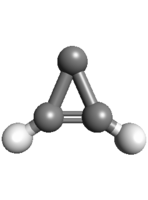Cyclopropenylidene, deuterated isotopolog with 13C on C2
 | |
|---|---|
| Species tag | 040517 |
| Version | 1* |
| Date of Entry | Dec. 2015 |
| Contributor | H. S. P. Müller |
|
The transition frequencies were taken from | |
| Lines Listed | 151 |
| Frequency / GHz | < 300 |
| Max. J | 6 |
| log STR0 | -7.0 |
| log STR1 | -4.5 |
| Isotope Corr. | -5.77 |
| Egy / (cm–1) | 0.0 |
| µa / D | 1.46 |
| µb / D | 2.93 |
| µc / D | |
| A / MHz | 33051.7 |
| B / MHz | 26731.3 |
| C / MHz | 14739.5 |
| Q(300.0) | 46170.8418 |
| Q(225.0) | 29984.0947 |
| Q(150.0) | 16322.9836 |
| Q(75.00) | 5777.7206 |
| Q(37.50) | 2048.7606 |
| Q(18.75) | 728.8733 |
| Q(9.375) | 260.9913 |
| Q(5.000) | 103.9753 |
| Q(2.725) | 43.5936 |
| detected in ISM/CSM | not yet |